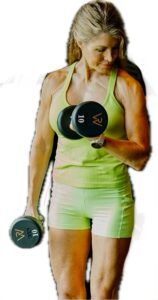Ever wondered how many sets and reps you really need to do to build muscle? The answer isn’t a simple number, but rather a dynamic approach based on your goals and how hard you’re willing to work. Let’s dive into what the science says about optimizing your training for maximum gains.
The Pillars of Muscle Growth:
- Reps and Sets: It’s All About Effort, Not Just Numbers
- The Myth: Many believe muscle growth only happens within a narrow rep range (e.g., 6-12 reps).
- The Reality: Research consistently shows that muscle can grow across a wide rep range—anywhere from 6 to 30 reps per set—as long as you’re working close to failure. This means the last few repetitions of your set should feel incredibly challenging, almost as if you couldn’t complete another one with good form.
- Practical Application: Don’t get fixated on a specific rep count. If you’re doing bodyweight squats, you might hit 20-30 reps before reaching near-failure. If you’re lifting heavy weights, it might be 6-8 reps. The key is the intensity of the effort.
- Rest Periods: Fueling Your Next Effort
- The Purpose: Adequate rest between sets allows your muscles to recover enough to perform effectively in the next round of work. This isn’t just about catching your breath; it’s about replenishing energy stores and clearing metabolic byproducts.
- The Guideline: Rest anywhere from 30 seconds to two minutes between sets.
- Shorter rests (30-60 seconds): Often used for higher rep ranges, bodyweight exercises, or to increase metabolic stress (the “burn”).
- Longer rests (60-120 seconds): Generally recommended for heavier lifting and lower rep ranges to ensure maximum strength and power for each subsequent set.
- Listen to Your Body: If you feel completely gassed and your performance drops significantly on the next set, you might need a bit more rest.
- Progressive Overload: The Non-Negotiable for Continuous Progress
- The Principle: To keep seeing results and encourage your muscles to adapt and grow, you need to consistently challenge them. Your body adapts quickly, so what was hard last week might be easy this week.
- How to Apply It:
- Increase Weight/Resistance: The most common method. (Not applicable to the no-equipment Tabata directly, but a general principle).
- Increase Reps: If you can do more reps with good form, do them!
- Adjust Tempo: Slow down the eccentric (lowering) phase of an exercise, or add pauses at the bottom of a squat. This increases time under tension. (This is one of my favorites –esp. if you have an injury, decrease the weight used and slow the tempo!)
- Add Sets: If you’re consistently hitting your target reps and feeling strong, add another set to your routine.
- Decrease Rest: As mentioned in the Tabata workout, skipping rest between exercises is a form of progressive overload.
- Improve Form: Better form allows you to target the muscles more effectively and often makes the exercise harder.
The Crucial Missing Piece: Recovery
Here’s the part most people miss: recovery is where the growth actually happens. Training is the stimulus that breaks down muscle tissue. Recovery is the process of rebuilding that tissue back stronger. If you’re training hard without recovering well, you’re essentially breaking down tissue faster than your body can rebuild it, leading to stagnation, fatigue, and potential injury.
- Sleep: Aim for 7-9 hours of quality sleep per night. This is when your body does most of its repair work.
- Nutrition: Provide your body with adequate protein for muscle repair, carbohydrates for energy, and healthy fats for overall function.
- Stress Management: Chronic stress can hinder recovery. Find ways to manage stress effectively.
- Deload Weeks: Every eight weeks, take a deload week. During this week, you significantly drop the intensity or volume of your workouts (e.g., half your usual sets or reps, or use lighter resistance). This helps to:
- Prevent overtraining and burnout.
- Reduce your risk of injury by giving joints and connective tissues a break.
- Reset your nervous system, allowing you to come back stronger and more energized for the next training cycle.
The bottom line: Muscle building is a cycle of stimulus and recovery. Get both of them right, and your body will respond with the strength and growth you’re looking for!
You got this!








